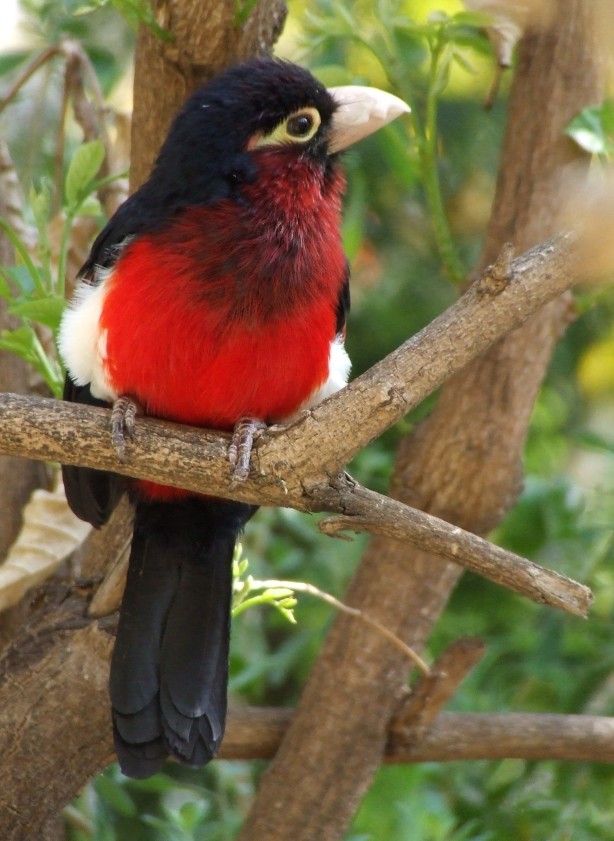- Lybiidae
Taxobox
name = African barbets

image_caption =Double-toothed Barbet "Lybius bidentatus"
image_width = 200px
regnum =Animalia
phylum =Chordata
classis =Aves
subclassis =Neornithes
infraclassis =Neognathae
superordo =Neoaves
ordo =Piciformes
subordo = Pici
familia = Lybiidae
familia_authority =
subdivision_ranks =Genera
subdivision = "Buccanodon "
"Gymnobucco "
"Lybius "
"Pogoniulus "
"Stactolaema "
"Trachyphonus "
"Tricholaema "The Lybiidae is a
bird family containing the African barbets. They were usually united with their South American and Asian relatives in theCapitonidae for quite some time [Short & Horne (2002)] , but this has been confirmed to be limited to the main South American lineageFact|date=May 2007. There are 42 species ranging from thetype genus "Lybius" of forest interior to thetinkerbird s ("Pogoniulus") offorest andscrubland . They are found throughoutsub-Saharan Africa , with the exception of the far south-west ofSouth Africa .The African terrestrial barbets, Trachyphoninae, range from the southern
Sahara toSouth Africa . Comprised of onegenus , "Trachyphonus", they are the most open-country species of barbets. The subfamily Lybiinae contains the African arboreal barbets. There are 36species of Lybiinae in 6genera .Description and ecology
They are usually about 20–25 cm long, plump-looking, with large heads, and their heavy bill is fringed with
bristles ; however the tinkerbirds are smaller, ranging down to theRed-rumped Tinkerbird ("Pogoniulus atroflavus") with a mere 7 g and 9 cm (3.6 inches) in length.They are mainly solitary birds, eating insects and fruit. Figs and numerous other species of fruiting tree and bush are visited, an individual barbet may feed on as many as 60 different species in its range. They will also visit plantations and take cultivated fruit and vegetables. Fruit is eaten whole and indigestible material such as
seed pits regurgitated later (often before singing). Regurgitation does not usually happen in the nest (as happens withtoucan s), althoughtinkerbird s do place stickymistletoe seeds around the entrances of their nests, possibly to deter predators. As the other barbets, they are thought to be important agents in seed dispersal in tropical forests.As well as taking fruit, African barbets also take
arthropod prey, gleaned from the branches and trunks of trees. A wide range on insects are taken, including ants, cicadas, dragonflies, crickets, locusts, beetles, moths and mantids. Scorpions and centipedes are also taken, and a few species will take small vertebrates such as lizards, frogs and geckos.The precise nesting details of many African barbets are not yet known, although peculiarly among the
Piciformes , some sociable species will nest in riverbanks or termite nests. Like many members of their order, Piciformes, their nests are in holes bored into a tree, and they usually between 2 to 4 eggs (except for the yellow-breasted barbet which lays up to 6), incubated for 13–15 days. Nesting duties are shared by both parents.There has been generally little interference by humans. Some of the species which require primary woodland are declining due to
deforestation , occasionally to the benefit of close relatives. For example the loss of highland woods inKenya has seen theMoustached Green Tinkerbird almost disappear and theRed-fronted Tinkerbird expand its range.ystematics
Subfamily Lybiinae
* Genus "Gymnobucco " (4 species)
* Genus "Stactolaema " (4 species)
* Genus "Pogoniulus " - tinkerbirds (9 species)
* Genus "Buccanodon " - Yellow-spotted Barbet
* Genus "Tricholaema " (6 species)
* Genus "Lybius " (12 species)Subfamily Trachyphoninae
* Genus "Trachyphonus " (6 species)It is not entirely resolved whether the Early to Middle
Miocene genus "Capitonides " fromEurope belongs to this family or theAsian barbet s (now Megalaimidae). Indeed, given that the prehistoric birds somewhat resembled a primitive toucan (without these birds' presentautapomorph ies), they might occupy a more basal position among the barbet-toucanclade altogether. On the other hand they show some similarities to "Trachyphonus " in particular and have even been placed into this genusMlíkovský (2002)] , but this move is not widely accepted."CMC 152", a
distal carpometacarpus similar to that of barbets and found at the Middle Miocene locality of Grive-Saint-Alban (France ) was considered to differ from "Capitonides" in the initial description, being closer to extant (presumably Old World) barbets [Ballmann (1969)] . This fossil is sometimes lumped into "Trachyphonus" too; in this case it may have more merit.Supposed
fossil remains ofLate Miocene "Pogoniulus " were found atKohfidisch (Austria ) [Mlíkovský (2002)] but are not yet thoroughly studied. It is not clear whether they belong to the extant genus but given the late date this may well be so.Footnotes
References
* (1969): Les Oiseaux miocènes de la Grive-Saint-Alban (Isère) [The Miocene birds of Grive-Saint-Alban (Isère)] . "
Geobios " 2: 157-204. [French with English abstract] doi|10.1016/S0016-6995(69)80005-7 (HTML abstract)
* (2002): "Cenozoic Birds of the World, Part 1: Europe". Ninox Press, Prague. ISBN 80-901105-3-8 [http://www.nm.cz/download/JML-18-2002-CBE.pdf PDF fulltext]
* (2002): Family Capitonidae. "In:" aut|del Hoyo, Josep; Elliott, Andrew & Sargatal, Jordi (eds.) "Handbook of the Birds of the World" (Volume 7: Jacamars to Woodpeckers). Lynx Edicions, Barcelona. ISBN 84-87334-37-7
Wikimedia Foundation. 2010.
